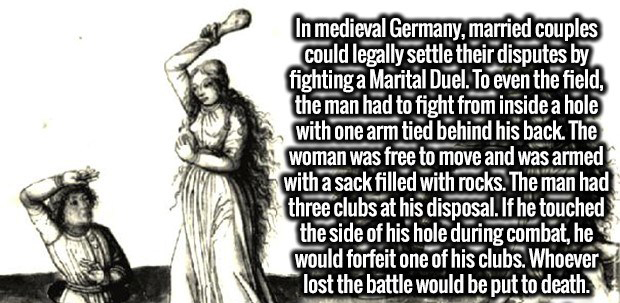Republished by Blog Post Promoter
 As opposed to single combat challenges such as chivalric duels or later private duels of honor, in the Medieval Ages in some regions of Europe, mostly in German principalities disputing parties would be obliged by authority to enter into a judicial combat. Such occasions could be huge spectacles for the community. Participants might be typically given a month or two to prepare. Certain formalities and ritual – varying from place to place – dictated the setting and conditions. In fact, besides civic and felon cases, the judicial combat sometimes was used as a tool for solving domestic disputes between husband and wife. The marital combat rules required to wear special attire – different in different places. Usually, competing husband and wife were required to wear a tight-fitting body suit with a hood (perhaps a ritual or burial outfit), as it was depicted in the 15th century fighting manual written by Hans Talhoffer. Another form of attire for a female participant was a special long chemise with an extended sack-like closed sleeve (in which a stone was placed) was required as the only clothing for a wife fighting against her husband as it as it was depicted in the 14th century fighting manual written by Paulus Kal.
As opposed to single combat challenges such as chivalric duels or later private duels of honor, in the Medieval Ages in some regions of Europe, mostly in German principalities disputing parties would be obliged by authority to enter into a judicial combat. Such occasions could be huge spectacles for the community. Participants might be typically given a month or two to prepare. Certain formalities and ritual – varying from place to place – dictated the setting and conditions. In fact, besides civic and felon cases, the judicial combat sometimes was used as a tool for solving domestic disputes between husband and wife. The marital combat rules required to wear special attire – different in different places. Usually, competing husband and wife were required to wear a tight-fitting body suit with a hood (perhaps a ritual or burial outfit), as it was depicted in the 15th century fighting manual written by Hans Talhoffer. Another form of attire for a female participant was a special long chemise with an extended sack-like closed sleeve (in which a stone was placed) was required as the only clothing for a wife fighting against her husband as it as it was depicted in the 14th century fighting manual written by Paulus Kal.
 So, in some regions of medieval Europe (more truly in the Holy Roman Empire), a wife might be allowed to fight her husband, with rigorous conditions being imposed to make the duel a fair one. There are a few written testimonies about such combats. In the year 1200 a man and his wife fought under the sanction of the civic authorities at Bale, in Switzerland. In 1228, a woman fought her husband in Berne, Switzerland, and soundly defeated him. German law provided that in such a case the man should be armed with three wooden clubs. He was to put be up to his waist in a three-foot wide hole dug in the ground, with one hand tied behind his back. The woman was to be armed with three rocks, each weighing between one and five pounds, and each one wrapped in cloth in form of a small sack. The man could not leave his hole but the woman was free to run around the edge of the pit. If the man touched the edge of the pit with either his hand or his arm, he had to surrender one of his clubs to the judges. If the woman hit him with a rock while he was doing so, she forfeited one of her stones. Bizarre as it may seem to us today, this marital duel was very far from play-acting. In the early Medieval Era, for both parties, the penalty for defeat could be death. If the woman won, the man was executed; if the man won, the woman was buried alive. Later, the terms seemed to be softened.
So, in some regions of medieval Europe (more truly in the Holy Roman Empire), a wife might be allowed to fight her husband, with rigorous conditions being imposed to make the duel a fair one. There are a few written testimonies about such combats. In the year 1200 a man and his wife fought under the sanction of the civic authorities at Bale, in Switzerland. In 1228, a woman fought her husband in Berne, Switzerland, and soundly defeated him. German law provided that in such a case the man should be armed with three wooden clubs. He was to put be up to his waist in a three-foot wide hole dug in the ground, with one hand tied behind his back. The woman was to be armed with three rocks, each weighing between one and five pounds, and each one wrapped in cloth in form of a small sack. The man could not leave his hole but the woman was free to run around the edge of the pit. If the man touched the edge of the pit with either his hand or his arm, he had to surrender one of his clubs to the judges. If the woman hit him with a rock while he was doing so, she forfeited one of her stones. Bizarre as it may seem to us today, this marital duel was very far from play-acting. In the early Medieval Era, for both parties, the penalty for defeat could be death. If the woman won, the man was executed; if the man won, the woman was buried alive. Later, the terms seemed to be softened.
